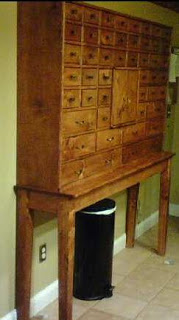 The apothecary dates back as far as you can trace herbalism and using natural means to cure the body of illness. How far back that is I really I don’t know, but what I do know is that the herbalist sure does have quite the selection of herbs, oils, and teas. Somewhere in the range of 100 different herbs, 30-40 or so teas and a few dozen different oils. With all those little items all over the place, the average kitchen isn’t really equipped to house those kinds of things, let alone if there are rug-rats running around getting into everything.
The apothecary dates back as far as you can trace herbalism and using natural means to cure the body of illness. How far back that is I really I don’t know, but what I do know is that the herbalist sure does have quite the selection of herbs, oils, and teas. Somewhere in the range of 100 different herbs, 30-40 or so teas and a few dozen different oils. With all those little items all over the place, the average kitchen isn’t really equipped to house those kinds of things, let alone if there are rug-rats running around getting into everything.
So my sister called me and said she wanted something made for all this stuff. We sat down together and came up with a concept, a wood type, and stain color. That led to a drawing and start of the casework at the Wall Woodworks workshop.
The carcass was 3/4″ dadoed on the sides and backs to receive the shelf dividers and back panel which was 1/2″. I needed 5 full length dividers and 4 smaller ones. Since I made the dividers from flat stock I didn’t need to make face frame material for the inner workings, only an outside band was needed. I constructed the dividers using pocket screws and glue.
Once the man carcass was completed, all the glue was dried and the face frame material was rounded over I began drawer construction. I really wanted too do half blind dovetails or an exposed box joint on the drawer fronts. Unfortunately due too the time constraints that was not possible. Instead the drawer fronts were rabbited on the sides which simplified the whole process. That way I could make adjustments too the drawer height as needed, since none of the drawers were the same size. Starting from the top it was about 3 1/4″ and the bottom row was 5 1/2″ I think. Making all these little drawers took quite a while, but everyone was unique and had character.

Once all of the drawers were completed and the center hatch was fitted with hinges and 2 tiny doors I could begin on the fabrication of the base. As you can see, the base is mortise and tenon joinery, the legs were tapered slightly starting with 2 7/8″ and ending in 2 1/2″, I really didn’t want to take to much meat off of them due to the weight of the case. The tenons I offset down from the legs about an inch too leave some meat at the top of the mortise. The table top was edge-glued and reinforced with biscuits every 6″ or so. After a dry fit on the base everything was glued together, sanded and then stained to match a mantle that she has in the house, which is an antique pine color. Overall I liked everything about the process from beginning to end in making this case and stand. My sister loved it and it has plenty of room for her to add more herbs, teas, and oils since she is gong to be putting more then one type in each drawer.
